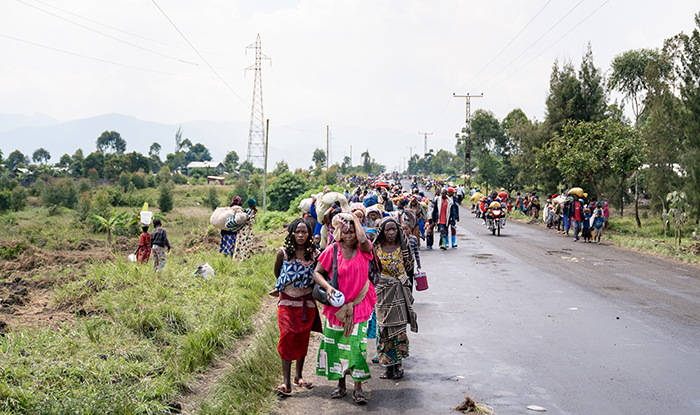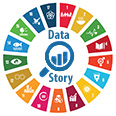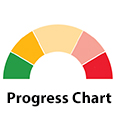Reduced inequalities

Displaced people in Goma, Democratic Republic of the Congo, where over 7 million people have been internally displaced.
© OCHA/Francis MwezeThe proportion of people living below half the median income is falling globally
Since 2000, two thirds of countries with data have reduced the proportion of their population living on less than half the median income. This trend continued during the pandemic. Data from 82 countries, representing 70 per cent of the world's population, indicate a slight decline in the proportion of people living below half the median income post-2019 compared to 2015-2019, dropping from 12.8 to 12.1 per cent. Progress has occurred in all regions except Central and Southern Asia, where the proportion remains relatively low at 9 per cent. Social assistance programmes, particularly in wealthier countries, largely explain reduced inequality during the pandemic. Latin America and the Caribbean has high levels of within-country inequality with at least 18 per cent of the population living on less than half the median income.
Proportion of population living on less than half the median income, 2015‒2019 and post-2019 (percentage)

* Excluding Australia and New Zealand.
Labour's share of GDP returns to a long-term decline as capital returns increase
Bucking a downward trend going back to the 1970s, the global labour income share of GDP rose sharply during the pandemic from 52.9 per cent in 2019 to 53.8 per cent in 2020. This increase should not be misinterpreted as a net gain for workers. During this period, global labour income decreased by 1.5 per cent in 2020, while global output fell even more, by 3 per cent. In 2021, the labour income share of GDP resumed its long-run decline.
The labour income share of GDP dropped from 54.1 per cent in 2004 to 52.7 per cent in 2021, representing a loss of $568 (purchasing power parity) per worker. This negative trend implies that rising labour productivity has not fully translated into higher labour compensation. Earnings from work are particularly important for less well-off and vulnerable people. At the same time, returns to capital have been rising, which can increase inequality as capital income is concentrated among the affluent.
Labour income share of GDP, 2004, 2019, 2020 and 2021 (percentage)

* Excluding Australia and New Zealand.
Half of the most vulnerable countries face a widening income gap with the wealthiest economies
For the first time this century, half of the 75 most vulnerable countries - those eligible for concessional lending from the World Bank's International Development Association (or IDA) - are experiencing a widening income gap with the wealthiest economies. A quarter of the global population - 1.9 billion people - live in IDA countries. One in three of these countries are poorer than before the pandemic.
Between 2020 and 2024, one in two IDA countries has achieved slower growth in income per capita than in the wealthy economies, the highest share since 2000. One in four people in IDA countries live on less than $2.15 a day, an extreme poverty rate that is more than eight times the mean for the rest of the world. Ninety per cent of people facing hunger and malnutrition live in IDA countries, half of which are in debt distress or at high risk of it.
Share of IDA countries with GDP per capita growth lower than in advanced economies, 1990-2024 (percentage)

Developing countries remain underrepresented in international economic decision-making
Developing countries make up 74 per cent of United Nations General Assembly Members but have limited voice and participation in international economic decision-making, norm-setting and governance. At the World Bank's main lending arm, developing countries hold only 39 per cent of voting rights, far short of their 75 per cent share of the bank's membership. At the International Finance Corporation, the World Bank's private sector lending arm, developing countries have just over 32 per cent of voting rights.
The International Monetary Fund completed two general reviews of quotas in 2019 and 2023 without any changes to their distribution (which helps to determine voting rights), leaving developing countries with only 37 per cent of voting rights. Other international financial institutions, such as regional development banks, have not undertaken any voting rights reforms since 2015 or announced plans to do so. The Fourth International Conference on Financing for Development in 2025 presents an opportunity to address these shortcomings and strengthen the legitimacy of global governance arrangements..
Remittance costs have fallen but not enough; digitalization could accelerate further decreases
Over the past decade, the cost of remittances has fallen significantly. The global average cost of sending $200 decreased from 7.42 per cent in 2016 to 6.18 per cent in 2023. This is still above the 3 per cent SDG target, however. In 2023, the highest costs for sending $200 in remittances were in Oceania (excluding Australia and New Zealand) and sub-Saharan Africa, at 8.33 per cent and 7.36 per cent, respectively, despite substantial progress in both regions since 2011.
Digital remittance services could help reach the target faster. In 2023, the global average cost of digital remittances was 4.84 per cent compared to 6.77 per cent for non-digital/cash-based remittances. Digital services comprised 30 per cent of all services in 2023. To achieve the SDG target, stakeholders could leverage digitalization to reduce costs, increase efficiency and improve remittance accessibility. Regulators need to address challenges such as limited competition, high compliance costs, account access barriers, transparency issues, and low digital and financial literacy.
2023 saw the highest number of refugees and was the deadliest year on record for migrants
By end-2023, a record 37.4 million refugees under UNHCR's mandate remained forcibly displaced from their countries due to war, conflict, persecution, human rights violations and events seriously disturbing public order. The number of refugees has increased year-on-year for more than a decade and doubled in less than seven years, outpacing durable solutions. By the end of 2023, 461 of every 100,000 people worldwide were refugees, more than double the 213 per 100,000 people at the end of 2015.
In 2023, a tragic milestone occurred as it became the deadliest year on record for migrants, with 8,177 fatalities documented. The majority of deaths occurred on routes taken by migrants affected by crises. Since 2015, over 57,000 migrant deaths have been recorded, although data collection challenges and limited responses mean that the actual number is likely much higher. The top countries of origin in terms of migrants losing their lives have active armed conflicts. They include Afghanistan, Ethiopia, Myanmar and the Syrian Arab Republic. Safe and accessible migration pathways are imperative as people continue to risk their lives on irregular routes given limited alternatives.
Countries of origin with the highest proportion of the population who are refugees, 2015 and 2023 (number of refugees per 100,000 people)


